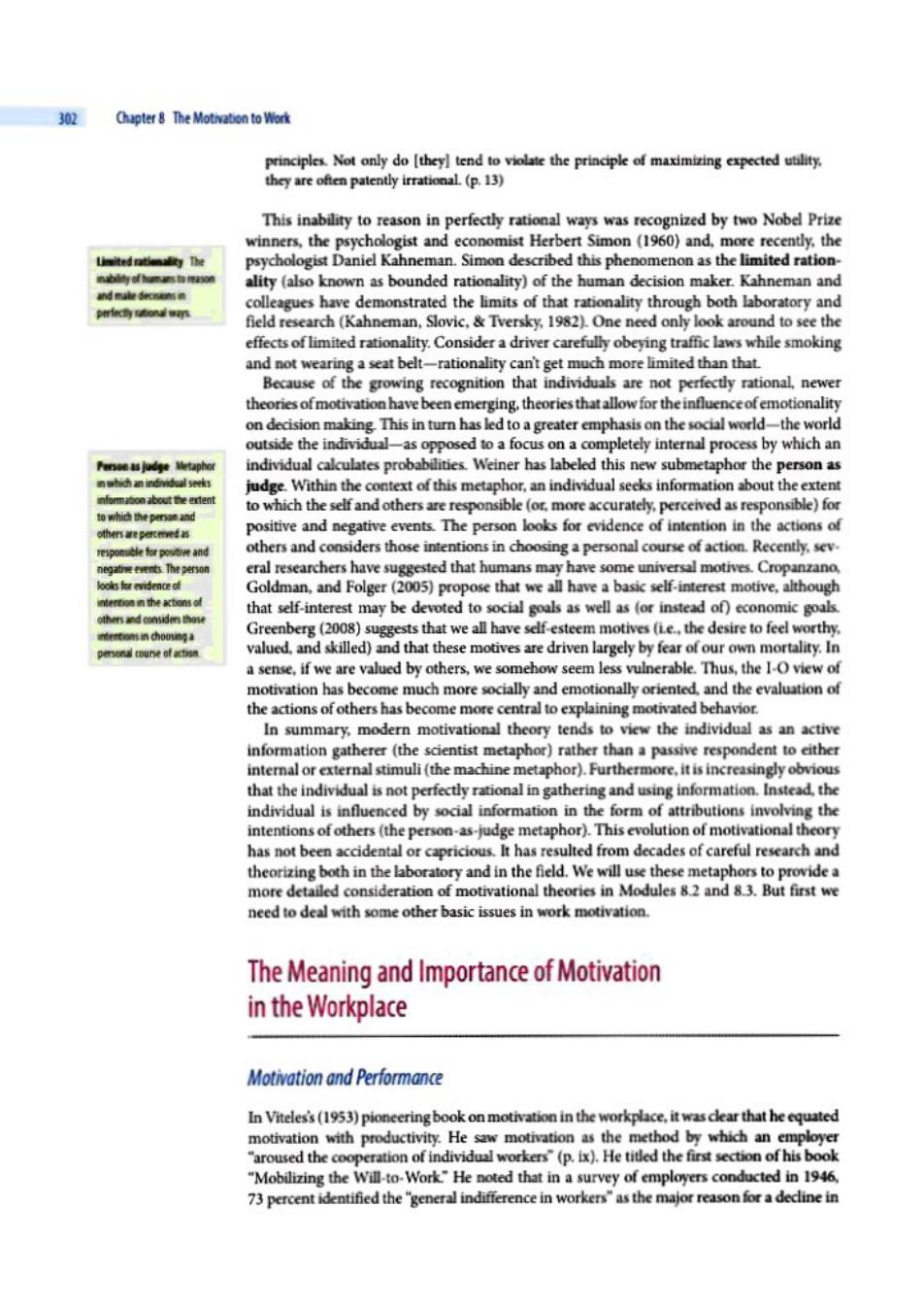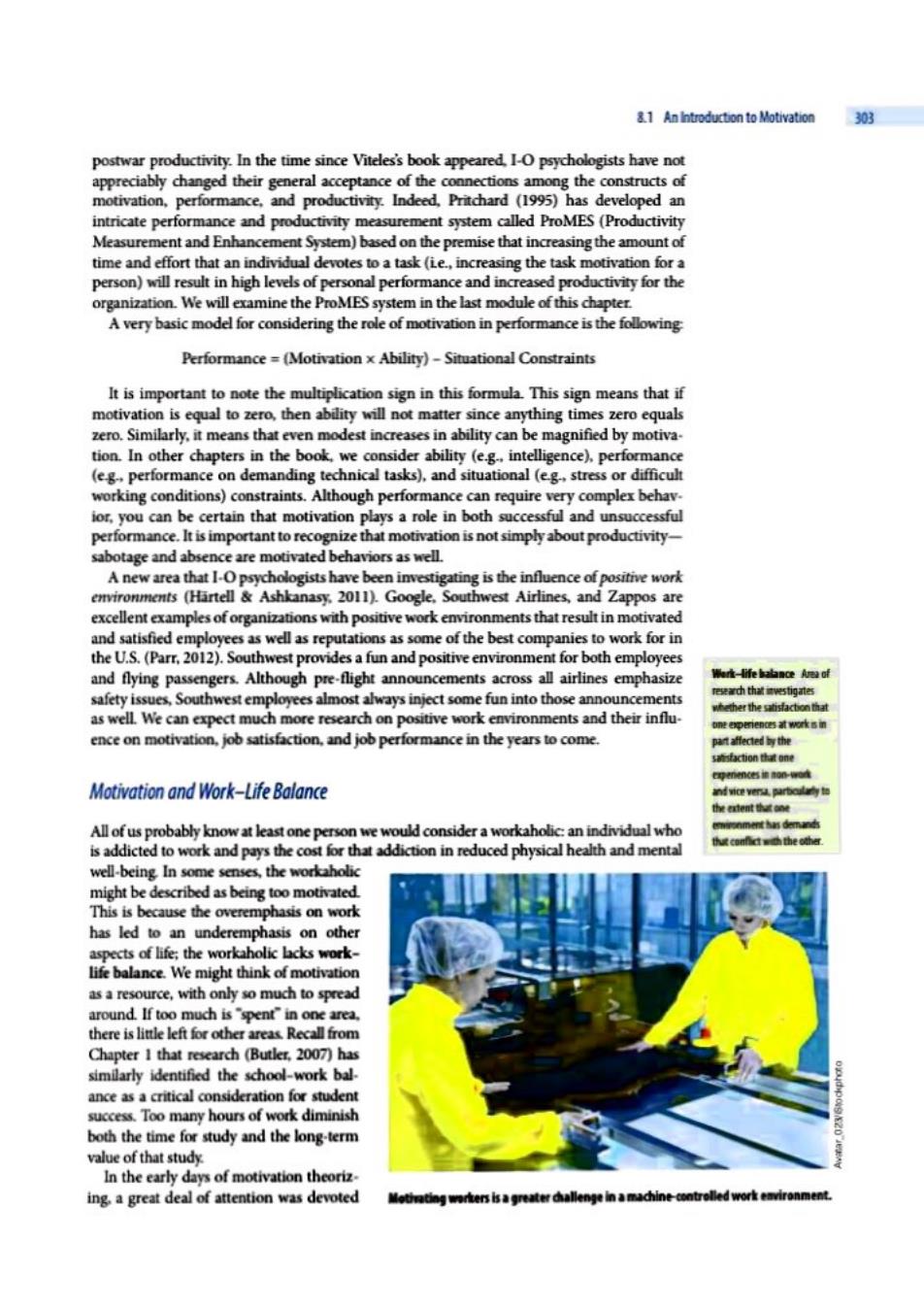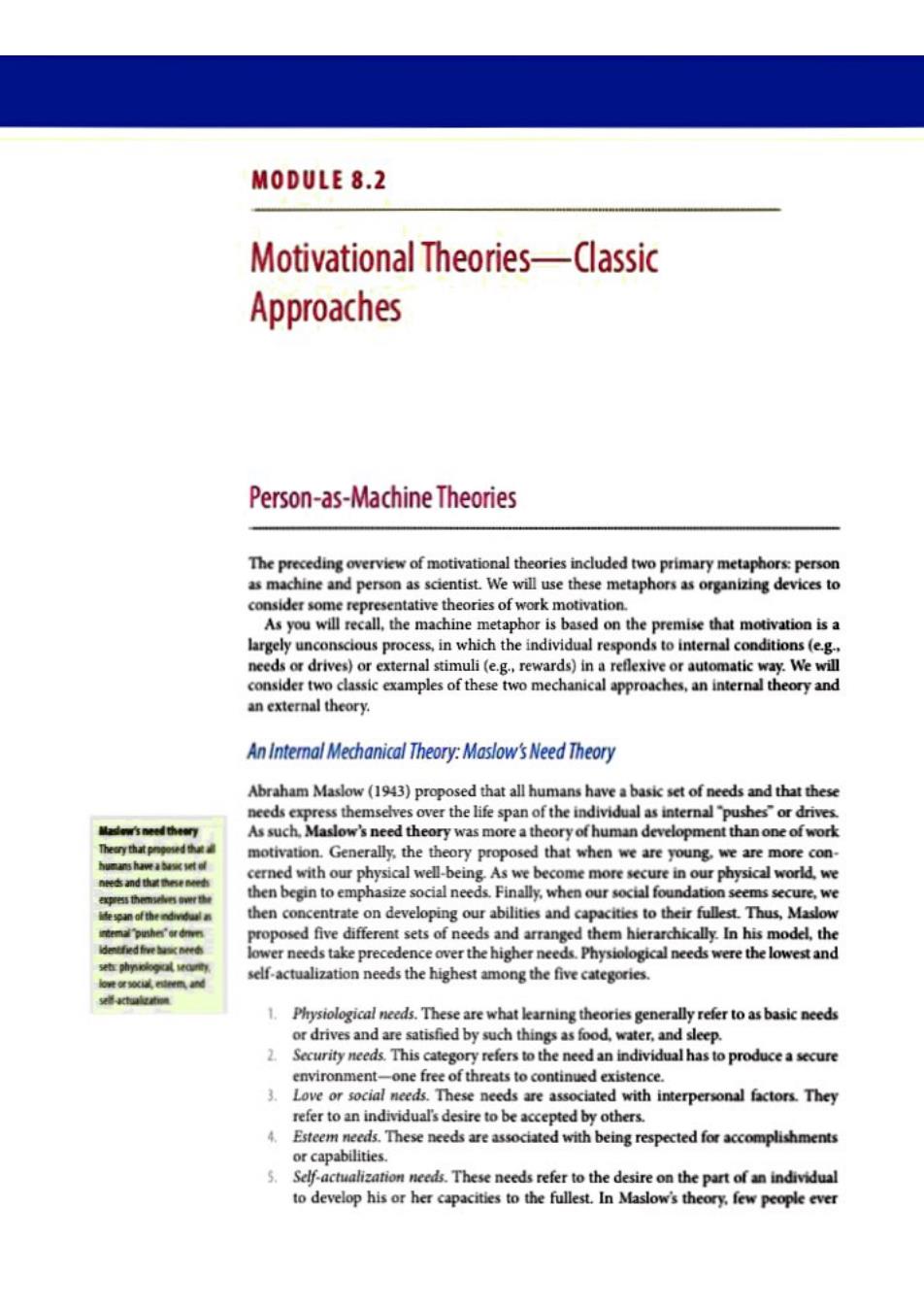
302 Chapter 8 The Motiation to Work principles.Not only do [theyl tend to violate the principle of maximizing expected utility. they are often patently irrational.(p.13) This inability to reason in perfectly rational ways was recognized by two Nobel Prize winners,the psychologist and economist Herbert Simon (1960)and,more recently,the psychologist Daniel Kahneman.Simon described this phenomenon as the limited ration. ality (also known as bounded rationality)of the human decision maker.Kahneman and and mahe decionsn colleagues have demonstrated the limits of that rationality through both laboratory and field research (Kahneman,Slovic,Tversky.1982).One need only look around to see the effects of limited rationality.Consider a driver carefully obeying traffic laws while smoking and not wearing a seat belt-rationality can't get much more limited than that. Because of the growing recognition that individuals are not perfectly rational,newer theories ofmotivation have been emerging,theories that allow for the influence ofemotionality on decision making This in turn has led to a greater emphasis on the social world-the world outside the individual-as opposed to a focus on a completely internal process by which an Persoe as judge Metaphor individual calculates probabilities.Weiner has labeled this new submetaphor the person as 菌whidan indidal seek灯 judge.Within the context of this metaphor,an individual seeks information about the extent informabon about the ertent to whid the persan and to which the self and others are responsible (or.more accurately,perceived as responsible)for he作etd5 positive and negative events.The person looks for evidence of intention in the actions of respontlefor posteand others and considers those intentions in choosing a personal course of action.Recently,sev. neg呢events.The person eral researchers have suggested that humans may have some universal motives.Cropanzano loolsfor evidence味 Goldman,and Folger (2005)propose that we all have a basic self-interest motive,although that self-interest may be devoted to social goals as well as (or instead of)economic goals. others and considers those Greenberg (2008)suggests that we all have self-esteem motives (ie.,the desire to feel worthy. valued,and skilled)and that these motives are driven largely by fear of our own mortality.In a sense,if we are valued by others,we somehow seem less vulnerable.Thus,the I-O view of motivation has become much more socially and emotionally oriented,and the evaluation of the actions of others has become more central to explaining motivated behavior. In summary,modern motivational theory tends to view the individual as an active information gatherer(the scientist metaphor)rather than a passive respondent to either internal or external stimuli (the machine metaphor).Furthermore.it is increasingly obvious that the individual is not perfectly rational in gathering and using information.Instead,the individual is influenced by social information in the form of attributions involving the intentions of others (the person-as-judge metaphor).This evolution of motivational theory has not been accidental or capricious.It has resulted from decades of careful research and theorizing both in the laboratory and in the field.We will use these metaphors to provide a more detailed consideration of motivational theories in Modules 8.2 and 8.3.But first we need to deal with some other basic issues in work motivation. The Meaning and Importance of Motivation in the Workplace Motivation and Performance In Viteles's(1953)pioneering book on motivation in the workplace,it was clear that he equated motivation with productivity.He saw motivation as the method by which an employer "aroused the cooperation of individual workers"(p.ix).He titled the first section of his book "Mobilizing the Will-to-Work"He noted that in a survey of employers conducted in 1946. 73 percent identified the 'general indifference in workers"as the major reason for a decine in

&1 An Itroduction to Motivation 303 postwar productivity.In the time since Viteles's book appeared,I-O psychologists have not appreciably changed their general acceptance of the connections among the constructs of motivation,performance,and productivity.Indeed,Pritchard (1995)has developed an intricate performance and productivity measurement system called ProMES(Productivity Measurement and Enhancement System)based on the premise that increasing the amount of time and effort that an individual devotes to a task (ie,increasing the task motivation for a person)will result in high levels of personal performance and increased productivity for the organization.We will examine the ProMES system in the last module of this chapter. A very basic model for considering the role of motivation in performance is the following Performance=(Motivation x Ability)-Situational Constraints It is important to note the multiplication sign in this formula.This sign means that if motivation is equal to zero,then ability will not matter since anything times zero equals zero.Similarly,it means that even modest increases in ability can be magnified by motiva- tion.In other chapters in the book.we consider ability (e.g.intelligence).performance (eg,performance on demanding technical tasks),and situational (eg.stress or difficult working conditions)constraints.Although performance can require very complex behav. ior,you can be certain that motivation plays a role in both successful and unsuccessful performance.It is important to recognize that motivation is not simply about productivity- sabotage and absence are motivated behaviors as well. A new area that I-0 psychologists have been investigating is the influence of positive work emvironments(Hirtell Ashkanasy.2011).Google.Southwest Airlines,and Zappos are excellent examples of organizations with positive work environments that result in motivated and satisfied employees as well as reputations as some of the best companies to work for in the U.S.(Parr,2012).Southwest provides a fun and positive environment for both employees and flying passengers.Although pre-flight announcements across all airlines emphasize 银h由ma健a威 safety issues,Southwest employees almost always inject some fun into those announcements hether the satist中ction that as well.We can expect much more research on positive work environments and their influ- an能老p6 riences at work卷前 ence on motivation,job satisfaction,and job performance in the years to come. part affected与he sfaction tha球Bne Motivation and Work-Life Balance ndvice作4 parbor奇e ke时d All of us probably know at least one person we would consider a workaholic:an individual who has demands hcom过hthe other is addicted to work and pays the cost for that addiction in reduced physical health and mental well-being In some senses,the workaholic might be described as being too motivated. This is because the overemphasis on work has led to an underemphasis on other aspects of life;the workaholic lacks work- life balance.We might think of motivation as a resource,with only so much to spread around.If too much is'spent"in one area. there is little left for other areas.Recall from Chapter I that research (Butler,2007)has similarly identified the school-work bal. ance as a critical consideration for student success.Too many hours of work diminish both the time for study and the long-term value of that study In the early days of motivation theoriz. ing.a great deal of attention was devoted Motating rers is a greater hallenge ina machine-controlled work emironment

30 Chapter8 The Motivation to Work to the concept of "energizing"an individual It was assumed that unless incentives were avail. able,an individual would remain passive. There is not much support for that view of motivation.Current motivational discussions revolve around the concept of direction more than that of simple energy enhancement.All people,unless ill or impaired,will expend energy in one way or another.The same prin- ciples that apply to work motivation will apply to the motivation to do things other than work In some senses,the employer is always compet- ing with other forces for the time and attention "What do you think...should we get started of the employee.Some employers might con. on that motivation research or not? sider a workaholic to be a"win"because the person devotes inordinate energy to work. The nonworkaholic employee feels tension between competing forces:work on the one hand,and family,leisure,school,and healthy activities on the other.A consideration of work motivation in a vacuum is a meaningless exercise.Work motivation can only have meaning within the context of a rich and complex life in which there are forces competing with the workplace for time and effort.We will consider the challenge of this work-life bal- ance in detail in both the next chapter and Chapter 10 when we consider stress. Motivation and Personality As we saw in Chapter 3.I-O psychologists generally agree that personality can be divided into dimensions such as agreeableness,conscientiousness,and so forth.We also saw that personal- ity can be a predictor of work performance and possibly even occupational choice.Since we know that motivation can also affect work performance,it is reasonable to consider what,if any,connections may exist between personality and work motivation.Judge and llies(2002) completed a meta-analysis on exactly that topic.They examined the relationship between measures of the Big Five personality traits and various indicators of motivation from several current motivational theories.These indicators included the number and difficulty of goals set by an individual,belief on the part of the individual that hard work would lead to rewards,and belief on the part of the individual in his or her ability to perform a task or job.Judge and llies found 65 studies and 105 correlation coefficients that could be included in the meta-analysis. The results showed that strong and consistent relationships do exist between personality characteristicsand performance motivation.Neuroticism was consistently negatively related to performance motivation (recall that the positive end of the neuroticism scale is emo- tional stability).In contrast,conscientiousness was positively related to all indicators of performance motivation.Put another way.conscientious and emotionally stable individu- als set more challenging goals,were more likely to believe that hard work would lead to rewards,and were more confident in their ability to accomplish a task or job. Research evidence continues to accumulate linking personality to motivation.Ng. Sorenson.and Eby (2006)conducted a meta-analysis of the relationships between locus of Leoes of comtrel The ertent control and motivation.Locus of control (LOC)refers to the extent to which an individual 每hch aniedadud ue明 views events as resulting from his or her own actions (an internal LOC)or from outside causes (an external LOC).People with an internal LOC believe that they can control their 00erm线市业0us色 environments;people with an external LOC believe that they are at the mercy of external environments with little ability to influence outcomes.The researchers'meta-analysis showed a clear and positive connection between an internal LOC and work motivation.The point here is not that people with an internal LOCare in better objective circumstances for affecting

8.1 An Introduction to Motivation 奶 outcomes,just that they believe they can control their fates.Xenikou(2005)also found a posi- tive relationship between an optimistic view of life(called a positive attributional style)and work motivation among Greek managerial and nonmanagerial employees.Further,she dis- covered that this optimism seemed to diminish with organizational tenure such that after four years with an organization,employees tended to grow more pessimistic in outlook. The personality-motivation connection is an important one.Past theories of work moti. vation gave little emphasis to individual difference measures such as personality traits.They tended to take a one-size-fits-all approach.Nor have work motivation theories paid much attention to individual differences in cognitive ability,assuming instead that everyone is smart enough to set and remember goals and to calculate expectancies.Perhaps one of the reasons why the person-as-scientist theories have lost ground to the person-as-judge theo. ries is because not everyone is as intelligent or emotion-free as thescientist"assumed by the theory.As motivation theory evolves into the person-as-judge metaphor,it should be increasingly valuable to look at personality traits in our attempts to understand work moti. vation.Equally interesting is the proposition of Kanfer and Ackerman (2004)that motiva- tion and performance will actually change over time as both cognitive abilities and personality change in middle and later adulthood. MODULE 8.1 SUMMARY Worker motivation has been a key interest for obvious that the individual is not perfectly rational 1-0 psychologists for almost a hundred years. in gathering and using information.Instead.the The earliest I-O theories of motivation were individual is influenced by social information in anchored in the notions of instincts.The term the form of attributions involving the intentions "instinct"was gradually replaced with terms of others(the person-as-judge metaphor). such as"need.""motive."and"drive." Early and modern approaches to motivation are Weiner suggested that the best way to understand based on the premise that increasing the amount the wide variation in motivational theories,as of time and effort that an individual devotes to a well as of the evolution of motivational thinking. task (ie..task motivation)will result in higher is through one of two metaphors:the person as levels of individual performance and increased machine and the person as scientist.Within these productivity for the organization.A basic model two metaphors.certain submetaphors have for considering the role of motivation in perfor- emerged as motivational theory has matured. mance is:Performance =(Motivation x Ability)- Situational Constraints Modern motivational theory views the individual as an active information gatherer (the scientist In recent decades.personality characteristics metaphor)rather than as a passive respondent to have become more important in the study of either internal or external stimuli (the person-as- work motivation. machine metaphor).Further,it is increasingly KEY TERMS motivation field theory person as judge instincts group dynamics work-life balance need person as machine locus of control drive person as scientist behaviorist approach limited rationality

MODULE 8.2 Motivational Theories-Classic Approaches Person-as-Machine Theories The preceding overview of motivational theories included two primary metaphors:person as machine and person as scientist.We will use these metaphors as organizing devices to consider some representative theories of work motivation. As you will recall,the machine metaphor is based on the premise that motivation is a largely unconscious process,in which the individual responds to internal conditions (e.g. needs or drives)or external stimuli (e.g.,rewards)in a reflexive or automatic way.We will consider two classic examples of these two mechanical approaches,an internal theory and an external theory. An Interal Mechanical Theory:Maslow's Need Theory Abraham Maslow (1943)proposed that all humans have a basic set of needs and that these needs express themselves over the life span of the individual as internal pushes"or drives. As such.Maslow's need theory was more a theory of human development than one of work motivation.Generally,the theory proposed that when we are young.we are more con- cerned with our physical well-being As we become more secure in our physical world,we then begin to emphasize social needs.Finally,when our social foundation seems secure,we escan of the ndivdaal a then concentrate on developing our abilities and capacities to their fullest.Thus,Maslow temat pushe了agn proposed five different sets of needs and arranged them hierarchically.In his model,the dentfied fve has need lower needs take precedence over the higher needs.Physiological needs were the lowest and self-actualization needs the highest among the five categories. 1. Physiological needs.These are what learning theories generally refer to as basic needs or drives and are satisfied by such things as food,water,and sleep. 2 Security needs.This category refers to the need an individual has to produce a secure environment-one free of threats to continued existence. 3 Love or social needs.These needs are associated with interpersonal factors.They refer to an individual's desire to be accepted by others. 4.Esteem needs.These needs are associated with being respected for accomplishments or capabilities. 5.Self-actualization needs.These needs refer to the desire on the part of an individual to develop his or her capacities to the fullest.In Maslow's theory.few people ever